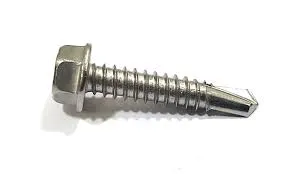M6 Hex Head Bolts for Reliable Fastening Solutions and High-Quality Performance
The Importance of M6 Hex Head Bolts in Modern Engineering
When it comes to assembling components in engineering and manufacturing, the choice of fasteners plays a crucial role in ensuring the durability and reliability of structures. Among the various types of fasteners available, the M6 hex head bolt stands out for its versatility and effectiveness across multiple applications. With the M denoting the metric system, the M6 hex head bolt has a nominal diameter of 6 millimeters, making it a popular choice for both light and heavy-duty applications.
Design and Features
The M6 hex head bolt typically embodies several design features that enhance its performance. The hexagonal head permits the use of a wrench for easy installation and removal, which is particularly beneficial in tight spaces where access may be limited. This design allows for greater torque to be applied, ensuring a secure fit that resists loosening over time due to vibration or stress.
Moreover, M6 hex head bolts are often made from various materials, including stainless steel, carbon steel, and alloy steel, catering to different environmental conditions and mechanical requirements. For instance, stainless steel M6 bolts are highly resistant to corrosion, making them ideal for outdoor applications or in industries where moisture is prevalent. In contrast, carbon steel bolts may be treated with coatings such as zinc plating for added rust resistance while maintaining affordability.
Applications in Various Industries
The M6 hex head bolt is extensively used across numerous sectors due to its reliable performance. In the automotive industry, these bolts secure components ranging from engines to chassis, ensuring the integrity and safety of vehicles. In the construction sector, M6 hex head bolts are employed in everything from framing and roofing systems to the assembly of prefabricated structures, contributing to the overall strength and stability of buildings.
m6 hex head bolt

Additionally, in the electronics field, M6 hex head bolts can be found in server racks to secure critical hardware components. The versatility of these fasteners extends to DIY projects, furniture assembly, and home repairs, making them an essential item for both professionals and hobbyists alike.
Advantages Over Other Fastener Types
One of the key advantages of using M6 hex head bolts over other fastener types, such as screws or rivets, is their ability to handle higher loads. The larger surface area of the hex head provides better torque transmission, which is essential for applications requiring significant load-bearing capacity. Furthermore, M6 hex head bolts can be reused multiple times without degrading their strength, unlike some other fasteners that may wear out upon repeated use.
Another benefit of M6 hex head bolts is their availability in a wide range of lengths and grades, allowing engineers and builders to select the right bolt for specific applications. This customization ensures that structural integrity is maintained while adhering to design specifications.
Conclusion
In conclusion, the M6 hex head bolt is an indispensable fastener in modern engineering and manufacturing. Its robust design, versatility, and ability to withstand rigorous demands make it a reliable choice across various industries. As technology advances and new materials are developed, the M6 hex head bolt will continue to evolve, maintaining its significance in the fastener market. Whether in automotive assembly lines, construction sites, or home workshops, the M6 hex head bolt will remain a cornerstone of secure and effective fastening solutions, underscoring its value in both industrial and everyday settings.
-
Weatherproof Plastic Expansion Anchors for OutdoorNewsJun.06,2025
-
Sustainability in the Supply Chain: Eco-Friendly TEK Screws ProductionNewsJun.06,2025
-
Load-Bearing Capacity of External Insulation FixingsNewsJun.06,2025
-
Double Head Bolts: Enhancing Efficiency in Industrial MachineryNewsJun.06,2025
-
Corrosion Resistance in Chipboard Screws: Coatings for Wholesale DurabilityNewsJun.06,2025
-
Butterfly Toggle Bolts : Enhancing Structural ResilienceNewsJun.06,2025
